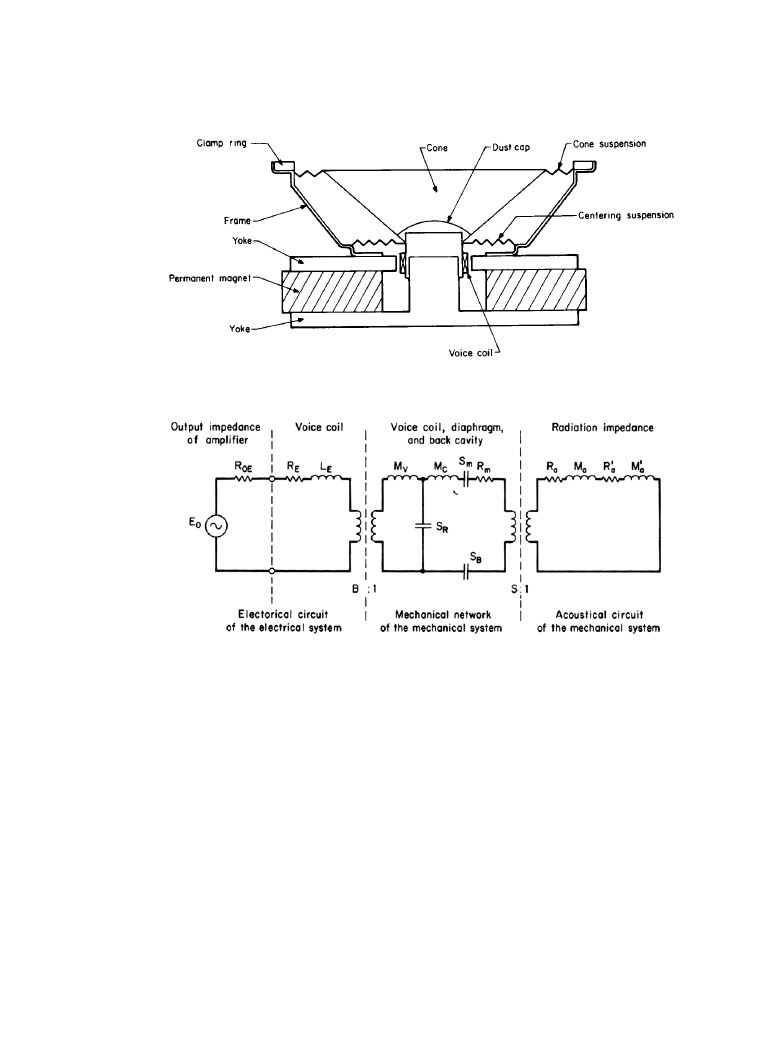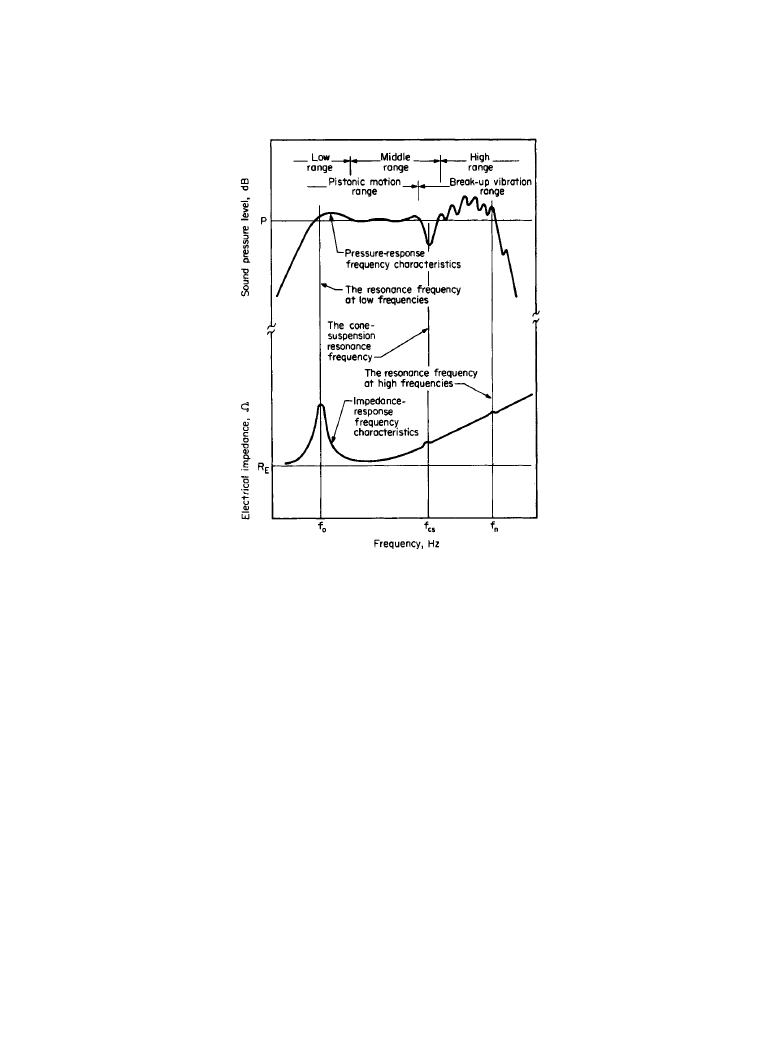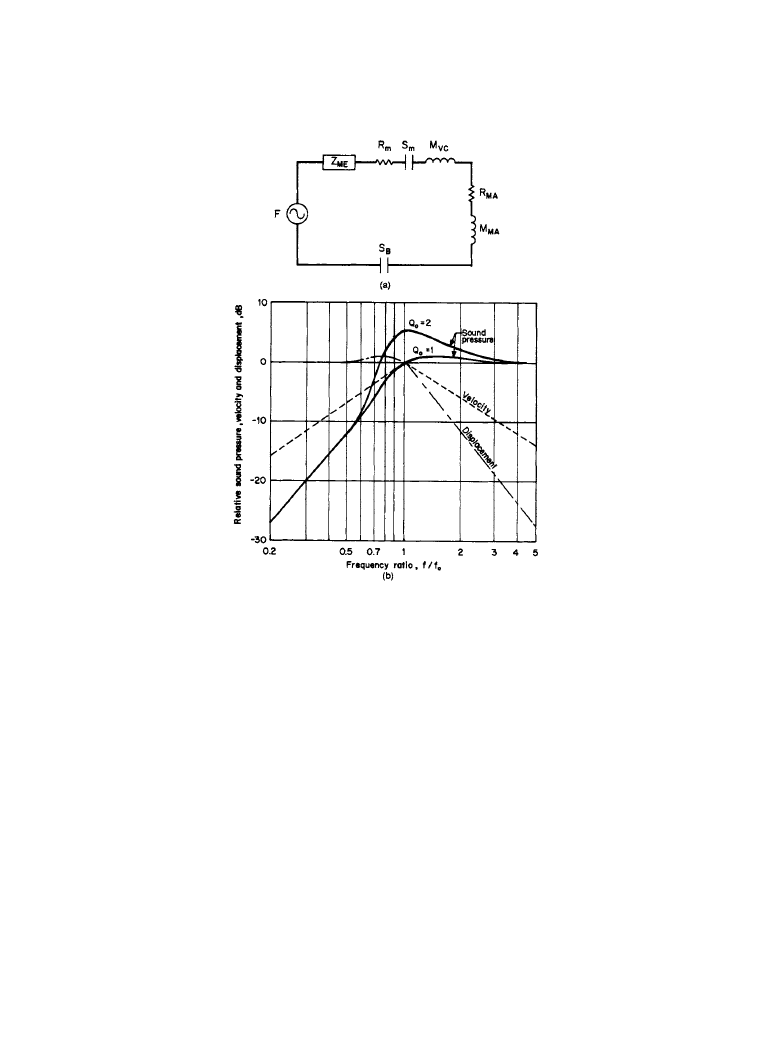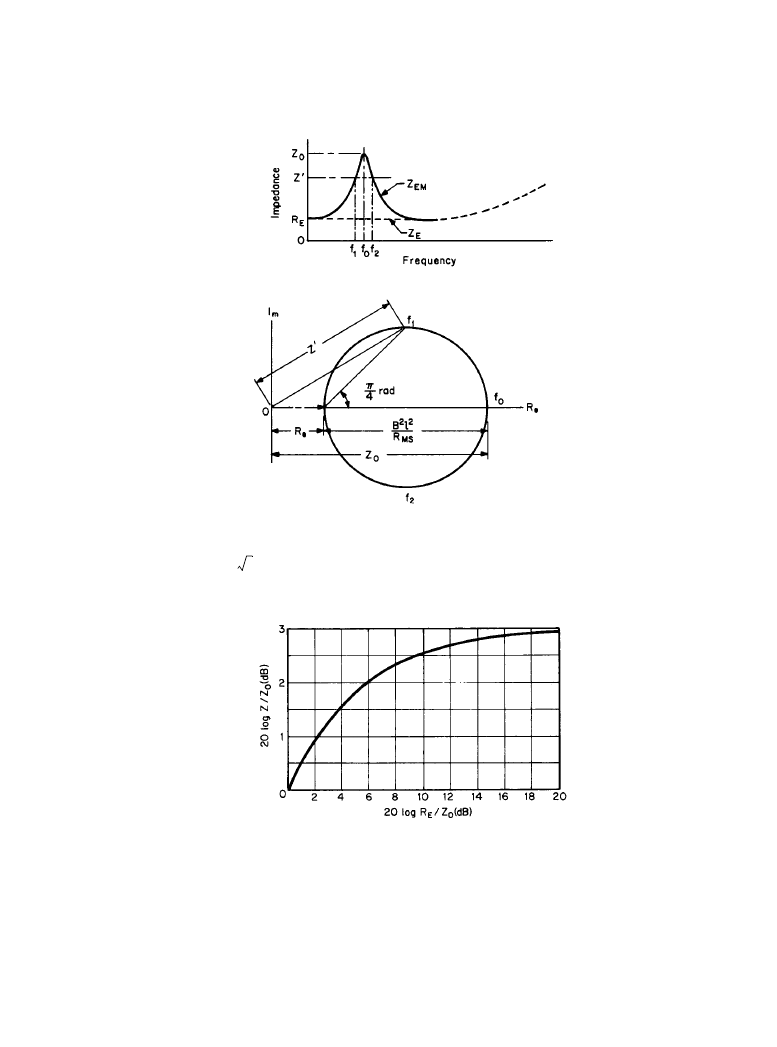ВУЗ: Казахская Национальная Академия Искусств им. Т. Жургенова
Категория: Книга
Дисциплина: Не указана
Добавлен: 03.02.2019
Просмотров: 21670
Скачиваний: 19

5-27
Chapter
5.3
Dynamic-Type Direct-Radiation
Speakers
Katsuaki Satoh
5.3.1
Introduction
The dynamic direct-radiation loudspeaker is divided broadly into the following components:
•
Magnetic circuit
•
Drive coil
•
Diaphragm
•
Support system
•
Frame
Although the construction of each speaker design is unique, the underlying fundamentals are the
same.
5.3.2
Operational Details
The typical configuration of a dynamic-type direct-radiation speaker is shown in Figure 5.3.1.
Most magnetic circuits are of the external type, using a ferrite magnet designed to generate a
magnetic-flux density of a few thousand to a few ten thousand G in an approximately 1- to 2-mm
air gap formed by the north and south poles. To control distortion, the drive coil provided in the
air gap is designed so that it does not move out of the uniform magnetic field formed by the mag-
netic pole because of vibration. Thus, the drive coil used has approximately 0.1-mm-diameter
windings of several turns. The impedance normally is a multiple of 4
Ω. The diaphragm is avail-
able in a variety of shapes and materials, as described later. The dust cap is used to prevent dust
from intruding into the magnetic air gap; when the cap must function as a damper, a permeable
material is used. Thus, the centering suspension and cone suspension function to: 1) support
these vibration systems, 2) hold the drive coil in the magnetic air gap, and 3) generate deempha-
sis in the axial direction.
Downloaded from Digital Engineering Library @ McGraw-Hill (www.digitalengineeringlibrary.com)
Copyright © 2004 The McGraw-Hill Companies. All rights reserved.
Any use is subject to the Terms of Use as given at the website.
Source: Standard Handbook of Audio and Radio Engineering

5-28 Sound Reproduction Devices and Systems
5.3.2a
Equivalent Circuit and Frequency Response
Figure 5.3.2 shows the equivalent circuit of a dynamic type of speaker. The sound-pressure-
frequency characteristics of the equivalent circuit are shown in Figure 5.3.3. An examina-
tion of these characteristics divided by frequency bands follows.
In low ranges, the diaphragm and support system are free from split vibration, but they
are considered to be a single resonance system. Thus, an equivalent circuit as shown in Fig-
ure 5.3.4a is produced. The velocity, amplitude characteristics, and sound pressure characteris-
tics on the axis are as shown in Figure 5.3.4b. As can be seen from this figure, Q
0
determines
sound pressure characteristics near the resonance frequency. If all element constants are found,
Figure 5.3.1
Structure of the dynamic direct-radiator loudspeaker.
Figure 5.3.2
Electromechanical equivalent circuit.
R
OE
= output impedance of amplifier,
Ω
;
R
E
=
resistance of voice coil,
Ω
;
L
E
= inductance of voice coil, H;
M
V
= mass of voice coil, kg;
S
R
= stiff-
ness between cone and voice coil, N/m;
M
C
= mass of cone, kg;
S
B
= stiffness of back cavity, N/m;
R
a
,
R
a
′
= radiation resistance of diaphragm, mechanical ohms;
M
a
,
M
a
′
= radiation mass of dia-
phragm, kg;
Bl = force factor; S = area of diaphragm, m
2
.
Downloaded from Digital Engineering Library @ McGraw-Hill (www.digitalengineeringlibrary.com)
Copyright © 2004 The McGraw-Hill Companies. All rights reserved.
Any use is subject to the Terms of Use as given at the website.
Dynamic-Type Direct-Radiation Speakers

Dynamic-Type Direct-Radiation Speakers 5-29
Q
0
can be obtained by calculation, but these constants must often actually be found by measure-
ment. Voice-coil impedance near the resonance frequency is expressed as a sum of electrical
impedance and motion impedance. That is,
(5.3.1)
When ,
(5.3.2)
Z
e
Z
c
A
2
Z
M
-------
+
=
R
c
ωL
»
Z
e
R
c
A
2
Z
M
-------
+
Re
1
1
A
2
r
m
------
------
1
A
2
j
ωm
---------
---------
1
A
2
1
j
ωC
m
-------------
-------------
-------------
+
+
-------------------------------------------
+
=
=
Figure 5.3.3
Frequency characteristics of the dynamic direct-radiator loudspeaker.
Downloaded from Digital Engineering Library @ McGraw-Hill (www.digitalengineeringlibrary.com)
Copyright © 2004 The McGraw-Hill Companies. All rights reserved.
Any use is subject to the Terms of Use as given at the website.
Dynamic-Type Direct-Radiation Speakers

5-30 Sound Reproduction Devices and Systems
The vector impedance locus is shown in Figure 5.3.5. From these results, Figure 5.3.6 is
obtained, and Q
0
can be found directly from electrical impedance. In midrange, cone suspension
less rigid than the diaphragm produces a split vibration. This phenomenon appears typically near
1000 Hz with a speaker using a paper-cone diaphragm. The analytical results of this condition,
using the finite-element method (FEM), are shown in Figure 5.3.7a. To eliminate this, damping
material is coated and the shape is redesigned, thus controlling the resonance. For the diaphragm,
specific resonance starts to appear, a peak and a dip in sound pressure response occur, and a
strain may result. Regarding this shortcoming, the results of analysis by FEM are shown in Fig-
ure 5.3.7b. To control this specific resonance, materials with a larger internal loss are used, the
shape of the diaphragm is changed from a simple cone to a paracurve, and corrugation is pro-
vided. Furthermore, when the frequency rises, elastic deformation concentrates at the junction
between the drive coil and the diaphragm, and stiffness S
R
appears there equivalently. Therefore,
Figure 5.3.4
Loudspeaker characteristics: (
a) mechanical equivalent circuit at a low-frequency
range, (
b) frequency characteristics of sound pressure, velocity, and displacement. Z
ME
= motional
impedance, mechanical ohms;
R
m
= resistance of vibrating system, mechanical ohms;
S
m
= stiff-
ness of vibrating system, N/m;
M
VC
= mass of vibrating system, kg;
R
MA
= resistance of radiating
system, mechanical ohms;
M
MA
= mass of radiating system, kg;
S
B
= stiffness of back cavity, N/m.
Downloaded from Digital Engineering Library @ McGraw-Hill (www.digitalengineeringlibrary.com)
Copyright © 2004 The McGraw-Hill Companies. All rights reserved.
Any use is subject to the Terms of Use as given at the website.
Dynamic-Type Direct-Radiation Speakers

Dynamic-Type Direct-Radiation Speakers 5-31
sound pressure is suddenly lowered at a higher level than the resonance frequency by S
R
and the
diaphragm mass, which actually presents the playback limit.
Figure 5.3.5
Loudspeaker voice-coil impedance and impedance locus.
R
E
= resistance of voice
coil,
Ω
;
Z = Z
0
/
,
Ω
;
B = magnetic-flux density in the gap, Wb/m
2
;
l = length of wire on voice-coil
winding, m;
R
MS
= resistance of vibrating system, mechanical ohms;
f
0
= resonance at low-fre-
quency range, Hz;
f = frequency at –3 dB, Hz.
2
Figure 5.3.6
Relation between
Z
′
and
Z.
Downloaded from Digital Engineering Library @ McGraw-Hill (www.digitalengineeringlibrary.com)
Copyright © 2004 The McGraw-Hill Companies. All rights reserved.
Any use is subject to the Terms of Use as given at the website.
Dynamic-Type Direct-Radiation Speakers